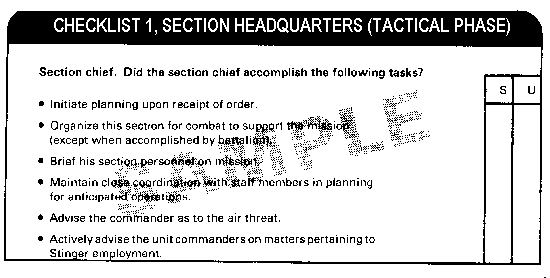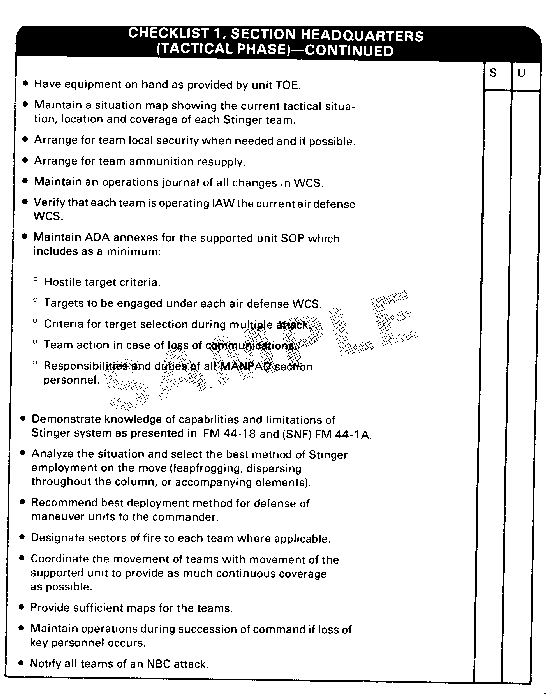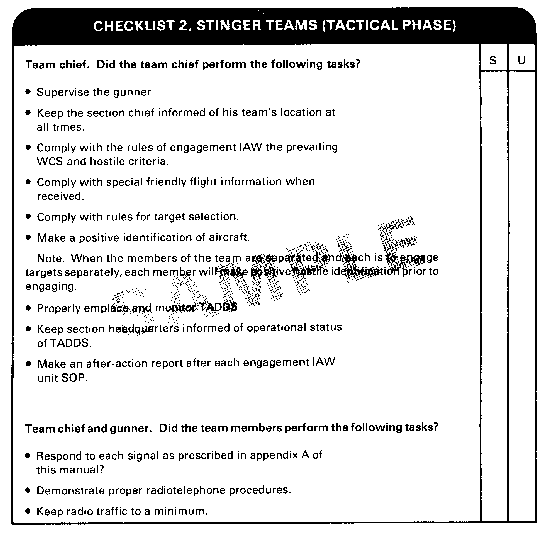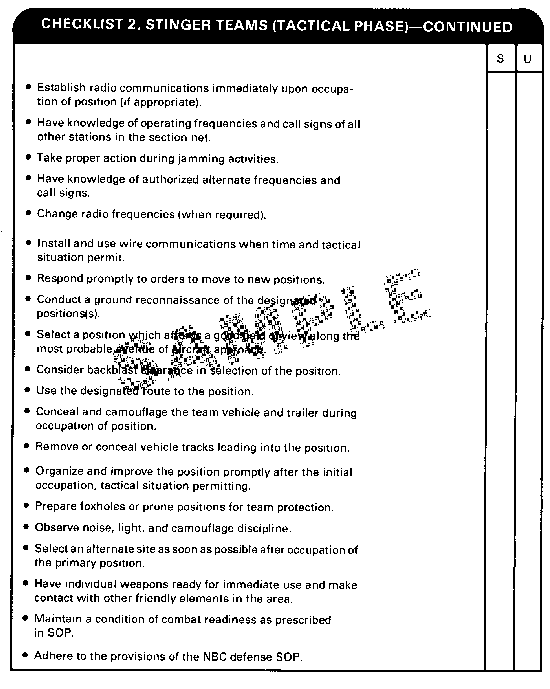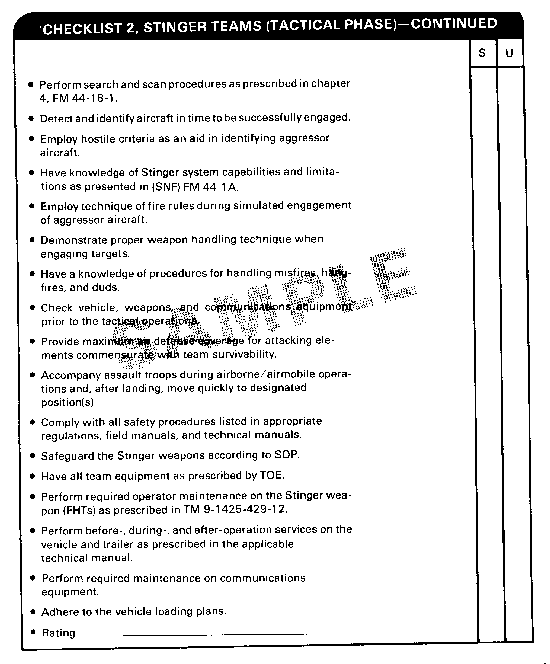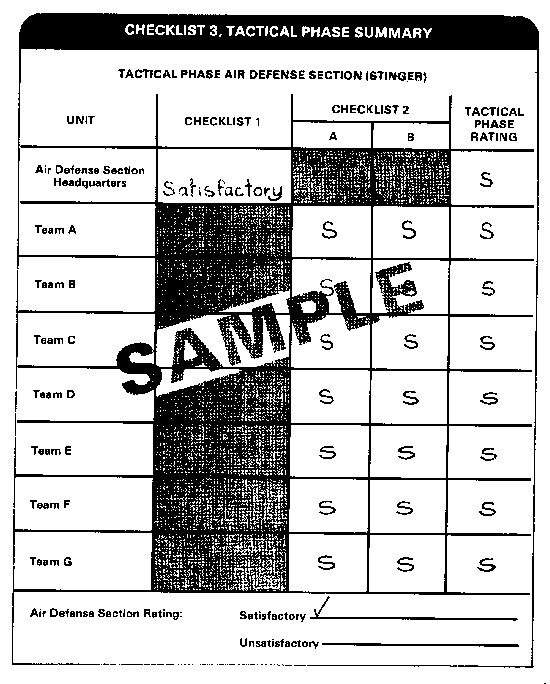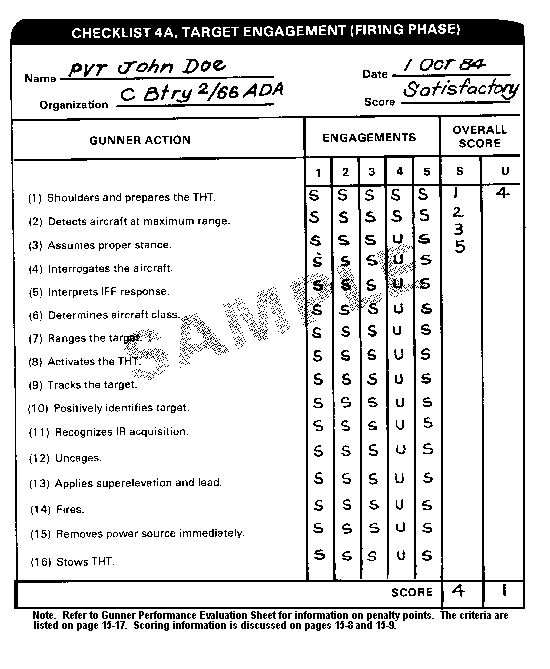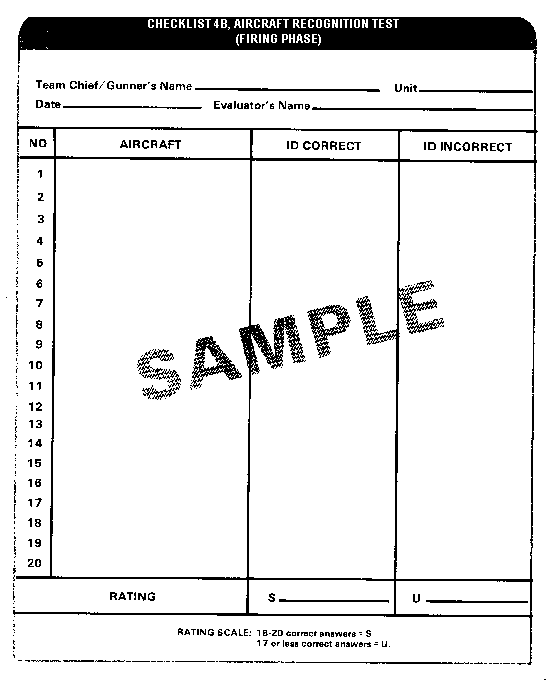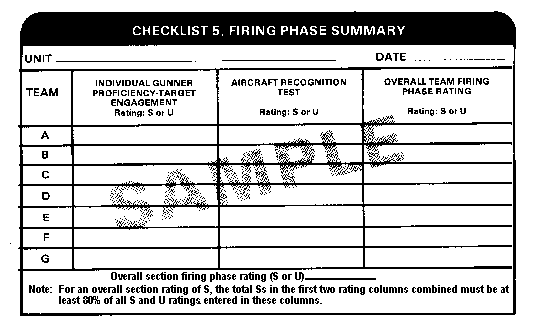CHAPTER 17
Operational Readiness Training Test
An operational readiness training test (ORTT) may be used to evaluate the air defense section headquarters element teams and gunners on their ability to conduct air defense operations under simulated combat conditions. Although the ORTT in this chapter has been written for Stinger sections and teams, it can also be modified to include the entire platoon. If the entire platoon is included, additional evaluators are required. However, there may be an insufficient number of evaluators to adequately assess the platoon. This situation may be remedied by designating evaluator teams to check the individual sections and teams at random.
Checklists shown in Chapter 17 are recommended checklist formats. Those shown are samples for your guidance.
OBJECTIVES OF THE TEST
The objectives of the test are to determine the combat readiness of the team, and the adequacy of training for the team.
DETERMINE COMBAT READINESS
To determine if the Stinger section can provide responsive and effective air defense support. This determination is made by evaluating their ability to--
DETERMINE ADEQUACY OF TRAINING
The ORTT will help determine the combat readiness and adequacy of training of individual team chiefs, gunners, and section headquarters personnel. The test will determine adequacy of training in the areas of command and control and communications, visual aircraft recognition, engagement of targets, and crew drills.
CONTENTS |
NATURE OF THE TEST
This test is conducted in two phases: tactical and firing (simulated). Each phase is conducted and rated separately and the resultant ratings are combined for the overall Stinger section rating.
TACTICAL PHASE
The Stinger section can be tested under two conditions. The section can undergo the tactical phase test by itself without troops. It may also be tested during one of its supported unit's field training exercises. In either case, the section provides air defense of its supported unit during simulated combat operations. The tactical phase consists of defense of stationary assets, defense of maneuver units, and defense of a convoy.
Defense of Stationary Assets
The section is evaluated on planning for air defense of the supported unit in a static defense posture. Test elements include defense design, reconnaissance, selection and occupation of position (RSOP) procedures, command and control, and conduct of the defense.
Defense of Maneuver Units
The section is evaluated on its ability to defend maneuver units against hostile aircraft. For example, a Stinger section is used in defense of a maneuver unit such as the company teams of a battalion task force when they are in contact with, or moving to contact the enemy.
Defense of a Convoy.
The section is evaluated on its ability to defend a convoy against air attack from low-altitude hostile aircraft.
FIRING PHASE
During the firing phase the proficiency of individual gunners in target engagement and aircraft recognition is tested. The firing phase consists of simulated target engagements and an aircraft recognition test.
Target Engagement
Target engagement is simulated using the THT to simulate the Stinger weapon. The MTS should be used to test gunner proficiency. The RCMAT may be used as a target for the test, if an MTS is not available (see chapter 14). This part of the test is explained in chapter 16.
Aircraft Recognition Test
Stinger teams are tested on their ability to visually recognize aircraft. This part of the firing phase should be conducted in a classroom environment. Use the GOAR kit or the applicable TEC test lessons. Test only on those aircraft which are relevant to the unit's theater of operations and those aircraft listed in FM 44-16S. Scoring criteria are explained in checklist 4b.
RATING SYSTEM
The rating awarded the air defense section at the conclusion of the test will be satisfactory or unsatisfactory. The overall rating will be determined by the chief evaluator based on the ratings awarded each area in the checklist. The narrative reports will reflect the degree to which the objectives stated previously were met, citing the strong and weak points of performance and a recommended rating.
The checklists in this chapter will be used as guides for determining these ratings. Local evaluators should expand these checklists for the specific section and situation being tested. Checklists will be scored as satisfactory or unsatisfactory. Checklist areas that are rated unsatisfactory will be supported by a statement justifying the rating.
At the discretion of the testing headquarters, when a section receives an overall rating of unsatisfactory, a complete retest may be ordered or the section may be retested in the unsatisfactory area(s). The following specific deficiencies concerning the ability to move, shoot, and communicate will result in an unsatisfactory rating:
TEST RESULTS
A written report of the test results will be submitted by the senior evaluator to the commander. The report should include, but not be limited to, checklists and narrative reports.
A narrative report will include the following:
ADMINISTRATIVE DETAILS FOR OVERALL TEST
The command conducting the test should be responsible for--
- Providing tracking range facilities.
- Providing an adequate number of training sets for Stinger teams to be tested.
- Designing courses to be flown by targets during simulated firings.
- Providing equipment and classroom space for the testing of aircraft recognition.
- Command and control procedures.
- Employment and tactics.
- Communications nets.
- Training set M134 and MTS M87A1.
The headquarters administering the test will provide sufficient FAARs to allow Stinger teams to employ the TADDS and receive early warning information.
Maps of scale 1:50,000/1:25,000 and aerial photos should be used. (Distribution will be IAW unit SOP.)
The chief evaluator conducting the test of the section may modify the test. He can do this to insure that the best use is made of existing facilities, to conform to conditions of the training situation, or to facilitate attainment of training objectives.
TACTICAL PHASE
The tactical phase of the air defense section ORTT can be conducted by modifying the supported unit's FTX. This can be done by including air defense situations that will require the section to defend the supported unit against low-flying hostile aircraft.
COMBAT SUPPORT
The Stinger section is a combat support element of the battalion. Therefore, employment and deployment of the section are based on the tactics employed by the supported maneuver in attack, defense, withdrawal, movement to contact, and defense of moving columns. The section should be tested during all phases of the supported unit's tactical phase with the exception of night operations.
TACTICAL MANEUVERS
Variations of tactical maneuvers made by the supported unit including retrograde operations, delay on successive positions, and relief, will also involve the deployment of Stinger to defend the battalion assets. The checklists covering each of the tactical operations can be modified to include requirements relating to a specific scheme of maneuver. If the supported unit does not conduct all of these type maneuvers, the Stinger section will not be rated for their actions concerning any maneuver omitted. A rigid scenario for each part of the tactical phase is not included because its sequence of timed events could conflict with the scenario of the supported unit.
TRAINING DEFICIENCIES
As each successive part of the tactical phase is tested, the evaluators record training deficiencies. The overall proficiency rating for each part of the tactical phase is recorded using the tactical phase checklist as a guide. Two checklists are used to evaluate the section's tactical phase. Checklist 1 is used to evaluate the section headquarters element. Checklist 2 is used to evaluate the Stinger team collectively.
PLANNING AND CONDUCT
The following are important in planning and conducting tactical training:
The section chief will take control of his teams, brief, and deploy them. The chief evaluator will remain with the section headquarters. The remainder of the evaluation team will accompany the Stinger teams to their deployment positions.
During the exercise, changes in WCS and air defense warnings are passed to the section headquarters over the supported unit's command net. (The evaluation team vehicle will be equipped with an FM radio.)
ADMINISTRATIVE DETAILS FOR TACTICAL PHASE
Stinger teams will be evaluated on their speed and reaction to air attack during all test requirements.
FIRING PHASE
The objective of this phase is to test the ability of the Stinger teams to recognize aircraft and engage aerial targets. The firing phase of the test should be conducted separately from the tactical phase at a time and place designated by the appropriate commander. The firing phase should be conducted in two parts: a simulated target engagement and a test on aircraft recognition. Simulated target engagements may be conducted with actual targets at a suitable tracking range or with the Stinger MTS.
SIMULATED TARGET ENGAGEMENT
Each team chief/gunner is required to engage five separate aircraft flying on courses planned by the testing command. The simulated engagements should be designed to present targets that will test the gunner's ability to visually detect targets, make correct decisions, and to demonstrate correct weapon handling procedures. Two engagements should be conducted under NBC conditions; that is, gunners masked.
Target courses described below apply to targets used to test gunners at a tracking range. If gunners are being tested at an MTS, the testing command should select five similar courses from appropriate film programs (reels) furnished with the MTS. Each gunner should be tested in the same manner using the same criteria for consistency. Target courses presently include the following variations:
Evaluators should score the target engagement part of the firing phase, using checklist 4A. (Checklists are located in this chapter.) The scoring procedure and evaluation criteria for the gunner are the same whether the MTS or the tracking range is used. This is because the THT is used for the gunner's evaluation in either case. The evaluator must be familiar with the THT and understand the procedures for evaluating gunner performance using the readout capability of this trainer. A complete operational engagement sequence with the trainer during evaluation of gunner proficiency is described in chapter 15.
AIRCRAFT RECOGNITION
During the aircraft recognition part of the firing phase test, 20 slides will be exposed for 5 seconds each. The slides should be limited to tactical aircraft which are relevant to the forward areas of the theater of operations. The test should be conducted using the same aircraft and criteria listed in the soldier's manual and the SQT for Stinger personnel.
Each gunner should identify the aircraft shown by writing its name or number designation in the space provided on checklist 4B. Sufficient time should be allocated between slides to allow the tested personnel to write their response. Ratings awarded during Parts I and II of the firing phase should be transferred to checklist 5 for use in the final ORTT summary.
EVALUATOR PERSONNEL
The requirements of the test must be thoroughly explained to all individuals in the section to be tested. Each evaluator must question personnel of the tested unit and must closely observe their performance so that he can rate effort and ability fairly and completely. In no case will members of the section being tested be detailed as evaluators. Evaluators will not give instructions or advice to unit personnel other than that necessary for the conduct of the test or to insure safety.
PERSONNEL
The test requires two evaluator officers, one of whom will serve as senior air defense section evaluator, and two enlisted men. The two officers should be helped by two qualified enlisted evaluators. Officers selected as Stinger evaluators should be experienced in the use of forward area air defense weapons and air defense tactics and also be familiar with the characteristics, capabilities, and limitations of the Stinger weapon. Enlisted evaluators should be qualified Stinger gunners and also be proficient as vehicle drivers and radio operators. One officer, assisted by an enlisted man, should act as evaluator of the section headquarters during the tactical phase while the other officer and enlisted man act as evaluators for Stinger team performance. During the firing phase, the evaluators should work together in evaluating gunner skills in engaging targets and in aircraft recognition.
DUTIES
Each evaluator will perform his assigned duties IAW instructions given by the senior evaluator. He also will--
CHECKLISTS
Checklists found in this chapter may be used in whole or in part, but it is highly recommended that local commanders review them to insure that they fulfill the training objectives in his unit. The commander and evaluators must refer to the latest pertinent field and technical manuals, local directives, and the unit SOP for current applicable information as a basis for revising the checklists.
Tactical Phase
Checklist 1 is used to evaluate the MANPAD section headquarters. The evaluator should check the S or U (satisfactory or unsatisfactory) column in the space provided for each item. After completing the checklist, the evaluator should award an overall rating to the section headquarters element. This overall rating should also be recorded in the appropriate space on checklist 3.
Checklist 2 is used to evaluate the Stinger teams during the tactical phase of the test. A separate checklist should be completed for each Stinger team. Team scores are entered in the appropriate spaces in checklist 3.
Checklist 3 is used to sum up the tactical phase ratings for the tested unit. The ratings awarded should approximate the average of A and B of checklist 2. The tactical phase scores from checklist 3 will be transferred to the appropriate spaces in checklist 6.
Firing Phase
Checklist 4A is used to score individual team members in their ability to engage aerial targets with the THT. At least four engagement ratings of "S" for each action in five engagements must be obtained before an overall score of "S" can be entered in the right-hand column. A separate checklist should be completed for each Stinger team chief and gunner. At least 80 percent overall scores of "S" must be obtained before the final grade of "S" can be assigned in checklist 4A.
Checklist 4B will be used to score the individual in aircraft recognition skills. These scores will be converted to ratings according to the rating scale at the bottom of checklist 4B.
Checklist 5 is used to summarize the firing phase ratings for the tested unit. Final ratings for checklists 4A and 4B will be entered on checklist 5.
Checklist 6 is used to sum up the tactical and firing phases for the tested unit and arrive at an overall score.
|
NEWSLETTER
|
| Join the GlobalSecurity.org mailing list |
|
|
|


